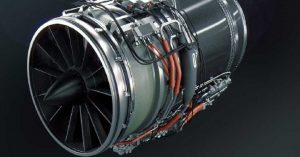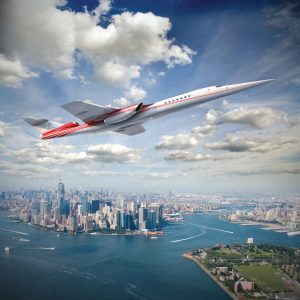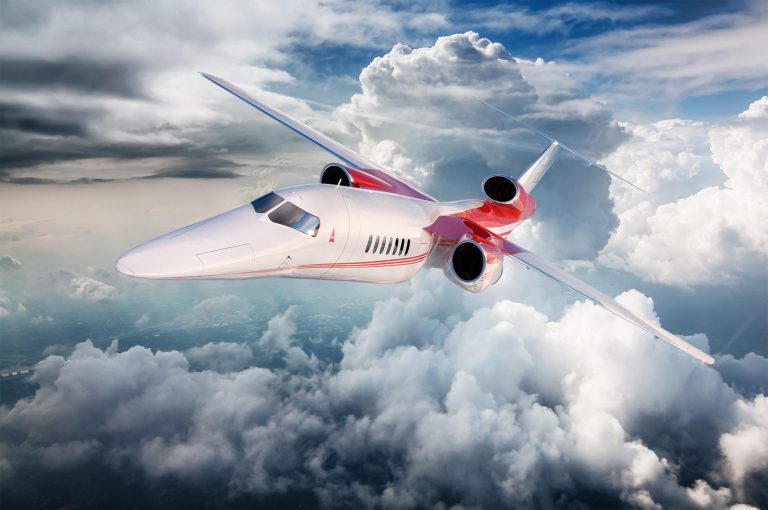The very real prospect of a purpose-built supersonic business jet (SSBJ)—and a new era in civil aviation—is coming into sharper focus.
When Aerion Corp. in 2004 introduced the world to its concept, the most formidable technical challenges were finding or designing an engine that could cruise supersonically and complying with strict airport noise-abatement restrictions. While the professional aviation community as a whole could admire the developers’ bold vision, most considered the notion more fantastical than realistic, given that 2011 was set as the target date for putting the proposed design into service. As it turned out, the skeptics were right.

Today, Aerion’s SSBJ program commands a whole new level of respect. The difference is the technological advances that have been made in the last 15 years in all of the most necessary enabling technologies—propulsion, takeoff and supersonic cruise, noise and carbon emissions controls, aerodynamics, structural design, and systems.
Then there are the marquee aerospace players who have gone on record expressing enough belief in the project to formally sign on as co-developers.
They include General Electric Co., which recently announced it is designing an engine called “Affinity” specifically for the AS2. This alone was a huge development that answered the all-important question of what would power the AS2. “Without an engine you do not have an airplane, and it is the enabler for this whole enterprise,” asserted David Richardson, director for air vehicle designs at Lockheed Martin Skunk Works, another program participant and a name that commands instant respect in any cutting-edge technological endeavor.

The Affinity engine will enable the AS2 trijet (three engines) to comply with tougher airport noise regulations scheduled to take effect for aircraft certified after 2020. Domestically, these stricter noise regulations are known as Stage 5; outside the U.S., they are referred to as Chapter 14.
Honeywell—one of the leading cockpit technology innovators in civil aviation—is another major player that has joined the team. It will lead the development of the AS2’s flight deck. While the sleek aircraft is being designed primarily to fly supersonically over water, under certain conditions it will be able to take advantage of the Mach cutoff phenomenon to enable flight over land at Mach 1.2 without the sonic boom reaching the ground. This will require engineers to develop algorithms to ensure the flight control system can automatically and reliably recognize these conditions in which the thicker air at lower altitudes prevents the boom from reaching ground level, effectively rendering the widely objectionable boom inaudible.
Aerion and its partners expect to complete preliminary design of the 12-seat, Mach 1.4-capable AS2 in June 2020, quickly followed by assembly of the first test aircraft, according to CEO Tom Vice. Flight tests are scheduled to get underway in 2023, with certification around 2025. Industry executives well versed in building and certifying clean-sheet-designed aircraft consider the timeline realistic. The projected market for a supersonic business jet ranges from around 150 to about 300 units per year.
“We see a viable market for the AS2,” Vice said, speaking as much to investors as he was to potential customers and other industrial partners. Indeed, Aerion’s long-range vision is for the AS2 to be the first in a family of SSBJs, “making supersonic travel efficient, sustainable and widely available,” as Vice put it. “It will be our springboard for larger and faster designs, both for business aviation and commercial airliners.”

If casual observers have sensed more buzz around the idea of supersonic jet travel in the last year or so, their impressions are very much on the mark: There is definitely a renewed interest in developing such airplanes. NASA has been conducting important research and development on a broad range of enabling technologies. There also has been a general increase in confidence among aerospace manufacturing heavyweights that technical challenges no longer represent the obstacles they did 15 or 20 years ago.
Another boost to Aerion and other developers of supersonic civil aircraft was recent reauthorization of the Federal Aviation Administration (FAA). Congress included language directing the FAA specifically to begin rulemaking to establish noise standards for commercial supersonic flight. This gave developers the long sought-after “regulatory certainty” needed to make design decisions, including the choice of engine. This helped immensely in establishing the business case for an SSBJ. Without such certainty, the idea of a supersonic business jet would continue to languish, according to some aerospace executives.
To underscore just how much of the renaissance in civil supersonic flight has taken hold, consider this: Boeing Commercial Airplanes has joined with hypersonic specialists conducting R&D on futuristic air vehicles to study a Mach 5 passenger airliner capable of cross the Atlantic Ocean in two hours or the Pacific in three hours. The study essentially is a preliminary step toward a long-range development plan. 12-seat, Mach 1.4-capable AS2.
